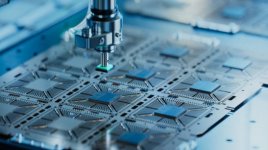Joey Moore
Member

MARKET OVERVIEW
The Russia semiconductor market size was valued at USD 8.5 Billion in 2024 and is projected to reach USD 17.9 Billion by 2033, growing at a CAGR of 8.70% between 2025 and 2033. This growth is driven by geopolitical isolation fostering self-reliance, significant investments in domestic chip production, and rapid technological advancements. Indigenous chip development and sourcing from non-Western countries are pivotal to the market's expansion. STUDY ASSUMPTION YEARS
- Base Year: 2024
- Historical Years: 2019-2024
- Forecast Year/Period: 2025-2033
RUSSIA SEMICONDUCTOR MARKET KEY TAKEAWAYS
- Current Market Size: USD 8.5 Billion (2024)
- CAGR: 8.70% (2025-2033)
- Forecast Period: 2025-2033
- The market is shaped by geopolitical isolation and sanctions that restrict access to advanced chips from global vendors.
- Russia aims to recreate Western microchips from the early 2000s by 2028, focusing on 65-nm technology.
- Domestic investments approximating $38.43 billion by 2030 are designated to advance local chip manufacturing and infrastructure.
- Technological strides include the development of lithography machines supporting 350nm to 14nm processes by 2030.
- Government initiatives and collaborations with non-Western countries support self-sufficiency.
MARKET GROWTH FACTORS
The Russian semiconductor market is driven by political isolation, sanctions by the United States and the European Union that restrict access to modern semiconductors and technologies from leading semiconductor manufacturers such as TSMC and Intel. As a result, the need to create a domestic semiconductor industry in Russia has strengthened in order to reduce reliance on foreign technologies. In July 2024, Russia announced that it will restart mass production of 2000s era microchips (mainly 65 nm technology). The original technology was developed in the 2000s by Mikron, Russia's largest microelectronics firm, as a response to Westerners adding other technological items to their sanctions list following Russia's annexation of Crimea.To counteract the sanctions and secure a stable supply of semiconductors, Russia is set to invest an estimated US$38.43 billion into the country's semiconductor industry by 2030, including upgrading local chipmakers, developing infrastructure, and building a skilled workforce. Short term goals include scaling up production using 90nm production technology by 2023 and beginning mass production of 28nm chips by 2030. Long-term goals include creating 14nm chips by 2030 and achieving self-sufficiency in chip production to strengthen the country's technology industry.
The focus of Russia's semiconductor industry is on the design and technology of integrated circuits (ICs) and materials for use in consumer electronics, industrial electronics, telecommunications and other electronic devices. In May 2024, Russia announced it completed its first lithography machine to fabricate 350nm technology chips. It is undergoing evaluation. Plans exist to develop lithography machines by 2026 for 130nm, by 2027 for 65nm and by 2030 for 14nm. Russia is working with non-Western countries to improve its position despite sanctions obstructing its ability to import foreign technology.
Market Segmentation
Component Insights:- Memory Devices: Semiconductor components designed to store data temporarily or permanently for computing and electronic applications.
- Logic Devices: Devices that perform logical operations essential for processing and computation.
- Analog IC: Integrated circuits handling analog signals for processing real-world signals.
- MPU: Microprocessor units that serve as the central processing units of electronic devices.
- Discrete Power Devices: Semiconductor devices managing high voltage and power for various applications.
- MCU: Microcontroller units integrating processors with memory and peripherals for embedded applications.
- Sensors: Devices that detect changes in the environment and convert them to electronic signals.
- Others: Additional semiconductor components not classified in the above categories.
- Silicon Carbide: A semiconductor material known for high thermal conductivity and efficiency in power devices.
- Gallium Manganese Arsenide: A compound semiconductor used in advanced spintronic and electronic applications.
- Copper Indium Gallium Selenide: Material commonly used in photovoltaic and semiconductor technologies.
- Molybdenum Disulfide: A layered material utilized for its electronic and mechanical properties.
- Others: Other materials used in semiconductor manufacturing not specified above.
- Automotive: Semiconductor components applied in vehicles for safety, navigation, and engine control.
- Industrial: Use of semiconductors in manufacturing, automation, and process control.
- Data Center: Semiconductors utilized in data storage, processing, and networking hardware.
- Telecommunication: Chips used in communication infrastructure and devices.
- Consumer Electronics: Devices like smartphones, tablets, and home appliances incorporating semiconductors.
- Aerospace and Defense: Applications in military, satellite, and aerospace electronics.
- Healthcare: Medical devices and diagnostic equipment utilizing semiconductor technology.
- Others: Additional end-user sectors utilizing semiconductors.
REGIONAL INSIGHTS
The Russia semiconductor market is segmented by region into Central District, Volga District, Urals District, Northwestern District, Siberian District, and Others. Specific market shares or CAGR values by region are not provided in the source. Nevertheless, the report covers a comprehensive analysis of these key regional markets, aiding in understanding geographic market dynamics.RECENT DEVELOPMENTS & NEWS
- October 2024: Russia announced plans to invest over 360 billion yen (approximately 240 billion rubles) in domestic semiconductor production by 2030. This aims to produce 65nm semiconductors and increase the local production of electronics manufacturing equipment and materials to 70%.
- February 2024: Mikron Group acquired DM2, an Italian company specializing in rotary transfer CNC machines, to expand its machining division and strengthen its market presence in precision applications.
- June 2024: Rostec launches the MP21 single-board computer powered by the domestically developed Elbrus 2S3 processor (2GHz, manufactured using TSMC's 16nm process). The MP21 targets industrial automation, aerospace, and security systems, aiming to enhance Russia's technological capabilities.
KEY PLAYERS
- Mikron
- Rostec
- Moscow Center of SPARC Technologies (MCST)
